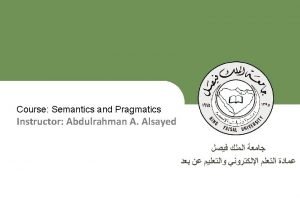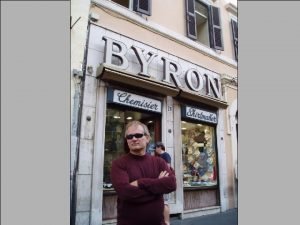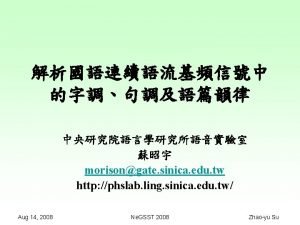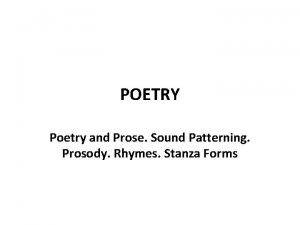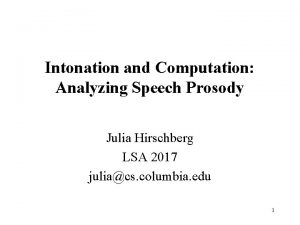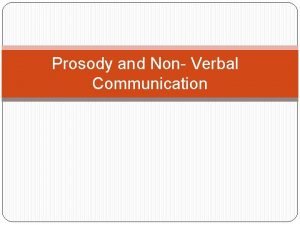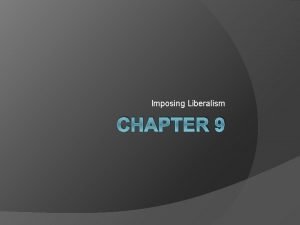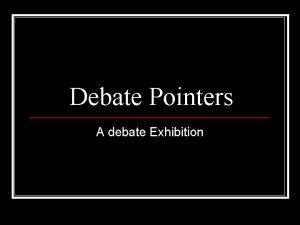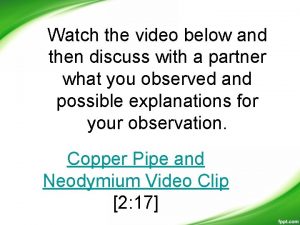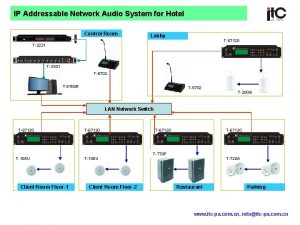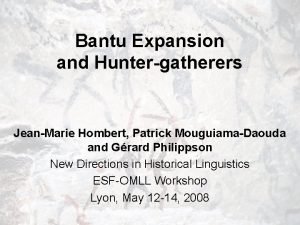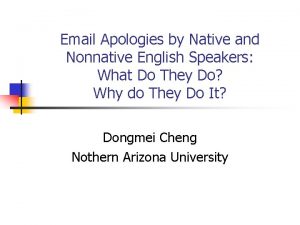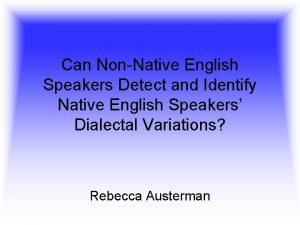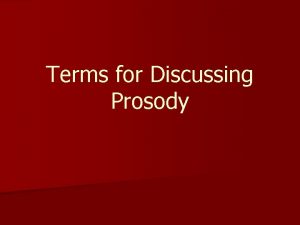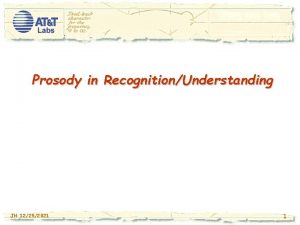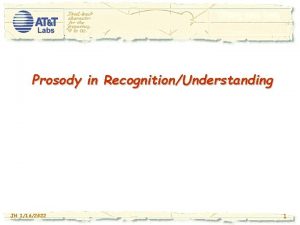Imposing native speakers prosody on nonnative speakers utterances

















- Slides: 17

Imposing native speakers’ prosody on non-native speakers’ utterances: Preliminary studies Kyuchul Yoon Spring 2006 NAELL The Division of English Kyungnam University

Contents • • • Acquiring prosody in language learning…. . . 3 Previous approaches……………. 4 A new tool………………… 5 Technical details……………. . . 6 Implications of the technique……………. 15 Preliminary plans for an experiment……. . 16 2

Acquiring prosody in language learning • One of the critical tasks in language learning • Prosody as non-segmental features of speech 1. phrase breaks 2. intonation (F 0) contour 3. segmental durations 4. intensity contour 3

Previous approaches • Explicit teaching of prosodic features such as the intonation contours, segmental durations, etc. • Audio aid Listen and repeat! • Visual aid in computer software Dr. Speaking® : F 0 contour comparison between native speaker and non-native speaker 4

A new tool • A new kind of audio aid in the form of a non-native speaker’s utterance with the prosodic features of a native speaker’s utterance • How this works 1. Software presents a native speaker’s utterance 2. A non-native speaker repeats the utterance 3. Software records the non-native speaker’s utterance 4. Software imposes the native speaker’s prosody onto the non-native speaker’s utterance 5. Software presents the processed non-native utterance 5

Technical details • Manipulation of 1. segmental durations, including phrase breaks 2. F 0 contours 3. intensity contours • For 1 and 2 PSOLA (Pitch Synchronous Over. Lap and Add), developed by Moulines & Charpentier, 1990 implemented in Praat • For 3 Intensity swap in Praat 6

Technical details original waveform Moulines & Charpentier, 1990 windowed waveform 1 2 3 4 5 6 7 8 9 10 11 12 13 14 15 16 17 18 19 shortened waveform 1 1 4 7 3 10 5 13 16 7 19 9 waveform with lower F 0 11 13 15 17 19 7

Technical details 1 Segmental durations • Segmental alignment & PSOLA processing : Alignment can be manual or automatic (with the help of speech recognition) k e. I m i native non-native k e. I m n i “…came in…” n 8

Technical details 2 F 0 contours • PSOLA processing on duration-treated utterance higher F 0 native k e. I m i n non-native k e. I m i n lower F 0 9

Technical details 3 Intensity contours • Mathematically “neutralize” non-native speaker’s intensity contour and transfer native speaker’s intensity contour in Praat – Holger Miterer (personal communication) native k e. I m i n non-native k e. I m i n 10

Technical details • Weakness 1. Voiceless segments can be made “voiced” in the windowing process (pitch-synchronous technique) 2. Excessive handling results in unnatural synthesis • Segment alignment should be fine-tuned according to the voiced/voicless status of the (sub-)segments for better results 11

Technical details Examples Praat script native utterance non-native utterance synthetic non-native 12

Technical details Comparison before synthesis – duration, F 0 & intensity (blue & yellow) native utterance non-native utterance 13

Technical details Comparison after synthesis – duration, F 0 & intensity (blue & yellow) native utterance synthetic non-native 14

Implications of the technique • The technique can be used in second language education: to facilitate/motivate acquisition of the target language prosody to emphasize the importance of prosody in achieving native speaker fluency • ASR (Automatic Speech Recognition) can be employed to automate the segment aligning stage 15

Preliminary plans for an experiment • Hypothesis The new type of audio feedback improves the efficiency of language, i. e. prosody, learning • Method Key idea: (In a listen-and-repeat type of language learning) Contrast the “old” type of audio feedback, i. e. playing native utterances only, with the “new” type of audio feedback, i. e. playing native and synthetic utterances. 16

Preliminary plans for an experiment • Method 1. Baseline: Grouping non-native learners into two (“good” and “bad”) 2. Administration: Learning either with the “old” type of audio feedback or with the “new” type of audio feedback 3. Evaluation: Evaluate the two type of feedback by examining the recordings of the learners In 1 and 3, a native speaker marks the recordings of the non-native learners on a categorical/numerical scale. In 2, the two groups (good/bad) are divided into four subgroups (good-A/good-B/bad-A/bad-B) so that A groups are given “old” type of audio feedback and B groups are given “new” type of audio feedback. 17
 Performative verbs
Performative verbs Asl prosody
Asl prosody Speech prosody
Speech prosody Terza rima structure
Terza rima structure Speech prosody
Speech prosody Verbal prosody
Verbal prosody Examples of imposing liberalism
Examples of imposing liberalism Rebutts meaning
Rebutts meaning Dear ladies and gentlemen
Dear ladies and gentlemen Electromagnet in speakers
Electromagnet in speakers Ip network audio system
Ip network audio system What is the speaker's tone?
What is the speaker's tone? Agora speakers
Agora speakers Contra viento y marea
Contra viento y marea Vansina
Vansina How to teach english to arabic speakers
How to teach english to arabic speakers Soundblock coaxial speakers creative commons pictures
Soundblock coaxial speakers creative commons pictures Speakers
Speakers
